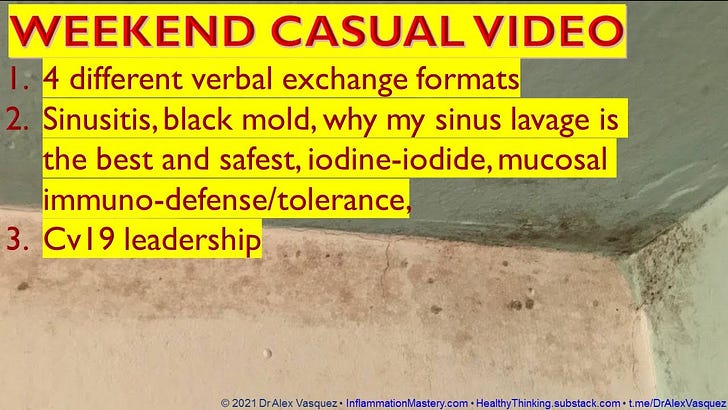Microbiome and Dysbiosis Video #6: Dysbiosis by Location—The Sinuses and Respiratory Tract (two videos)
People can have dysbiotic microbial colonizations in multiple locations (multifocal) by different microbes (polydysbiosis); this scenario commonly shows a dose-dependent relationship with disease
This page was updated February2025 to include the video directly embedded (not streaming from another host) for better reliability/viewability. The video is available/viewable at the bottom of this page directly from the substack platform.
Update 2025: All videos are being re-uploaded in Feb-May 2025 to provide direct and reliable access through the substack platform:
Microbiome Dysbiosis (1) Course Overview and Introduction to Major Concepts and Mechanisms
Microbiome Dysbiosis (3) Prototypes of Dysbiosis-Induced Disease (VIDEO:1hour,42minutes=102minutes)
Microbiome Dysbiosis (7) Dysbiosis by Location—Genitourinary Tract
Microbiome Dysbiosis (8) Dysbiosis by Location—Blood, Tissue, Parenchymal Dysbioses
Microbiome Dysbiosis (9) Dysbiosis by Location—Skin and Environmental Dysbiosis
MICROBIOME DYSBIOSIS (10) Gut Dysbiosis Prototypes and Solutions, part1, part2, part3, part4, part5
MICROBIOME DYSBIOSIS (11a) GUT-BRAIN AXIS and OPTIMAL DIET, Part 1 of 2 parts covering everything you need to know
People can have dysbiotic microbial colonizations in multiple locations (multifocal) by different microbes (polydysbiosis); this scenario commonly shows a dose-dependent relationship with disease, such as diabesity (eg, gut, mouth, blood) and the prototypic autoimmune conditions rheumatoid arthritis and psoriasis (eg, gut, mouth, genitourinary tract, and—specific to psoriasis and eczema—the skin). The two conditions most noted to have sinorespiratory dysbiosis are systemic lupus erythematosus (ie, SLE, lupus) and granulomatosis with polyangiitis, formerly called Wegener's granulomatosis.
Of additional note is that many people harbor Staphylococcus aureus in their nostrils, and this can serve as a reservoir for infecting surgical wounds; for this reason, disinfecting the nostrils with 5% povidone iodine helps to reduce the risk of surgical infections, as noted for orthopedic surgery and cardiac surgery.
VIDEO: Microbiome and Dysbiosis #6 (1 hour and 34 minutes) Dysbiosis by Location—The Sinuses and Respiratory Tract
Reminders and refreshments regarding video technicalities
This video is viewable only on the website at this page (use browser) for Dysbiosis video no6, even though the text is visible in the app
This video is available to, for, and by the supporting/paid subscribers who have shown interest in these topics
See the Course Index for the complete list of videos and related books and articles
Adjustments for volume, rewind, and full-screen mode are within the video frame; if needed, see additional instructions on how to watch videos here
Thank you for supporting this effort and buying me a coffee while I work in exchange for the years, weeks, and hours invested in preparing, recording, and editing this video.
Recall that I discussed this in my conversation on black mold and nasal lavage—video included below, with the full discussion and notes available at healthythinking.substack.com/p/weekend-casual-video-on-sinusitis.
Dr Alex Kennerly Vasquez (introduction; brief Bio-CV) writes and teaches for an international audience on various topics ranging from leadership to nutrition to functional inflammology. Major books include Inflammation Mastery, 4th Edition (full-color printing, 1182 pages, equivalent to 25 typical books [averaging 60,000 words each]), which was also published in two separate volumes as Textbook of Clinical Nutrition and Functional Medicine (Volume 1: Chapters 1-4; Volume 2: Chapter 5—Clinical Protocols for Diabetes, Hypertension, Migraine, Fibromyalgia, Rheumatoid Arthritis, Psoriasis, Vasculitis, Dermatomyositis and most other major inflammatory/autoimmune disorders); several sections have been excerpted including Antiviral Strategies and Immune Nutrition (ISBN 1502894890) (aka, Antiviral Nutrition [available as PDF download] and Brain Inflammation in Chronic Pain, Migraine, and Fibromyalgia. Dr Vasquez’s books are available internationally via bookstores such as BookDepository, Amazon.com, Barnes and Noble, ThriftBooks, AbeBooks, BetterWorldBooks, WaterStonesBooks and his new Telegram channel is https://t.me/DrAlexVasquez.




